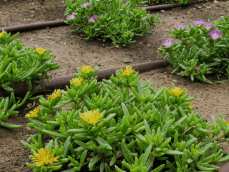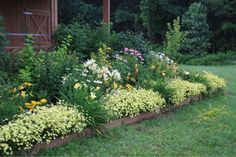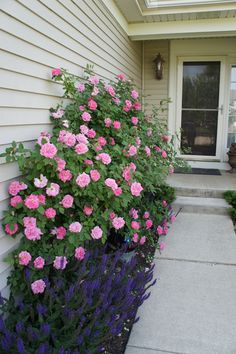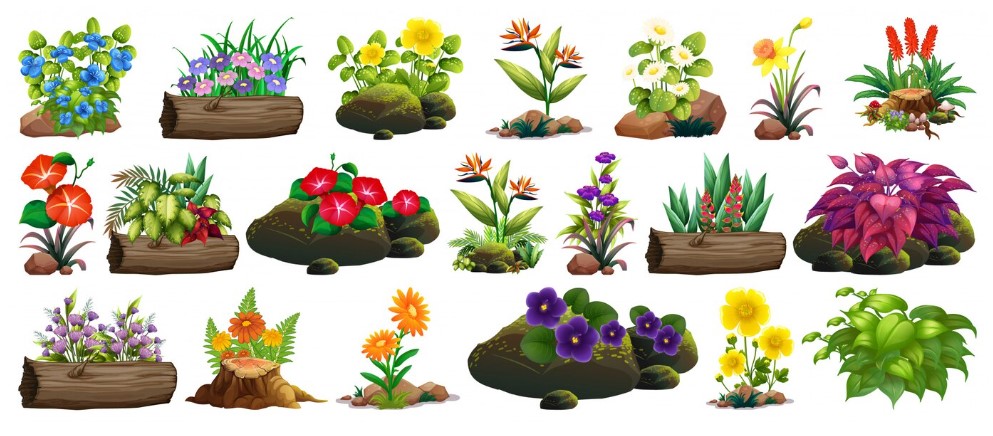Small, low-growing plants that do well in rock gardens are called rock garden plants. These plants do best in full sun and soil that drains well, which makes them great for rocky areas.
Rock gardens are made to look like natural mountain or alpine landscapes. They make a beautiful, low-maintenance landscape. It’s important to pick plants for a rock garden that can do well in the rough, dry conditions that are common in rocky places.
The important thing is to pick plants that don’t need much water and can grow in bad soil. Best Rock Garden Plants come in many shapes, sizes, and colors, so you can make designs that are artistic and look good. Picking the right plants is important for a successful and healthy landscape, whether you’re making a new rock garden or adding to an old one.
Yellow Alyssum (aurinia Saxatilis)
Yellow Alyssum, which is also called Aurinia saxatilis, looks lovely in rock gardens and does best in sunny, well-drained spots. Its bright yellow flowers and easy care make it a great choice for rock gardens that need a splash of color and texture.
01. Yellow Alyssum (aurinia Saxatilis)
The lovely Yellow Alyssum, which is also called Aurinia saxatilis, is a low-growing annual plant in the brassicaceae family. It’s often used in rock gardening because of its sweet-smelling flowers that are bright yellow. This is why you might want to add Yellow Alyssum to your rock garden:
- Bright Yellow Blooms: Bright yellow flowers on Yellow Alyssum add a splash of color to any rock garden. The bright flowers make your yard look beautiful and bring in pollinators that are good for you.
- Fragrant Scent: The flowers of Yellow Alyssum smell sweet, like honey, which makes your garden more enjoyable to smell and experience.
- Drought Tolerant: This tough plant does well in dry, rocky places, which makes it a great choice for rock gardens that don’t get a lot of water.
- Low Maintenance: Once it’s established, Yellow Alyssum is very easy to take care of and doesn’t need much attention. It does best in dirt that drains well and can grow in a variety of soil types.
- Ground Cover: Because it spreads so easily, Yellow Alyssum makes a thick mat of leaves that covers bare ground and stops weeds from growing in rock gardens.
02. Ice Plant (delosperma Cooperi)
Want to add something bright to your rock garden? You might want to add the Ice Plant (Delosperma cooperi). It looks great in rock gardens because it does well in full sun and well-drained soil. The leaves are very fleshy, and the flowers are bright pink to purple.

Ice Plant (delosperma Cooperi)
- The ice plant, which is also called “Delosperma cooperi,” is a beautiful and easy-to-care-for shrub. It is famous for the bright, daisy-like flowers that grow in a wide range of colors, such as pink, purple, orange, and yellow. These flowers look beautiful in rock gardens.
- The ice plant does well in dry, well-drained soil and can handle drought, which makes it a great choice for rock gardens and dry areas.
- Its fleshy, succulent roots and leaves not only look nice, but they also help the plant survive times when it doesn’t have enough water.
- Bees, butterflies, and other good bugs love this plant’s flowers, making it a great choice for gardeners who want to draw pollinators.
- The ice plant can grow well in harsh conditions and has beautiful flowers, which makes it a great choice for rock garden fans who want to add something strong and beautiful to their outdoor space.
03. Angelina Stonecrop (sedum Rupestre ‘angelina’)
It’s also called Sedum rupestre ‘Angelina’. Angelina Stonecrop is a colorful and easy-to-care-for rock garden plant. Its bright golden leaves make any rock garden look more interesting. This succulent can handle drought and does best in full sun and dirt that drains well. This makes it a great addition to rock gardens.
Angelina Stonecrop (sedum Rupestre ‘angelina’)
All rock garden lovers need to have these low-growing plants. Angelina Stonecrop plants come in bright golden leaves and don’t need much care. They add color and texture to any yard. In the summer, its small star-shaped flowers open, drawing in pollinators and making the plant look even more interesting.
Here are the most important things to remember about Angelina Stonecrop:
- Drought-tolerant and hardy: It grows best in sandy, rocky, or well-drained soil, which makes it a great choice for rock gardening.
- Versatile and easy to grow: This plant can be used as a ground cover or in a pot garden, and once it’s established, it doesn’t need much care.
- Seasonal color changes: Angelina Stonecrop’s leaves change from bright yellow in the summer to orange and red in the fall, making the plant look nice all year.
- Attracts pollinators: Angelina Stonecrop’s bright flowers attract bees and butterflies, which is good for the biodiversity of your yard as a whole.
Because it is so unique and easy to work with, Angelina Stonecrop is a great addition to rock gardens that makes the room look even better.
04. Dragon’s Blood Stonecrop (sedum Spurium)
A great plant for your rock garden is Dragon’s Blood Stonecrop, which is also called Sedum spurium. It adds a striking splash of color and texture to the environment with its red-tinged leaves and low growth. Any level of gardener can grow this hardy annual plant because it is very easy to take care of.
Dragon’s Blood Stonecrop (sedum Spurium)
Dragon’s Blood Stonecrop, whose scientific name is Sedum spurium, is a tough succulent plant that doesn’t need much care and looks great in rock gardens. The bright pink and red flowers add color to the yard and draw in pollinators. Dragon’s Blood Stonecrop is important for your rock garden because:
- Drought Tolerance: Dragon’s Blood Stonecrop can handle drought very well, which makes it a great plant for rock gardening in dry areas.
- Low Maintenance: This plant is great for busy farmers or people who are just starting to garden because it doesn’t need much care.
- Ground Cover: Dragon’s Blood Stonecrop is a great ground cover because it spreads quickly and fills in gaps between rocks. It also keeps weeds from growing.
- Seasonal Interest: In addition to its beautiful red flowers, this plant has pretty leaves that change color with the seasons, making it more appealing all year long.
Dragon’s Blood Stonecrop is a beautiful and useful plant that requires little care. It can be used in many ways and looks great in rock gardens.
05. Hens And Chicks (sempervivum Tectorum)
These plants, called Hens and Chicks or Sempervivum tectorum, are popular in rock gardens because they don’t need much care and can survive in harsh conditions. With rosettes and offsets, these succulents make a cute grouped look. For best results, plant them where the dirt doesn’t stay soggy. They look great in rock gardens.
Hens And Chicks (sempervivum Tectorum)
Hens and Chicks, or Sempervivum tectorum, is a favorite rock garden plant because of its unique look and low maintenance needs. This succulent plant does best in dry, rocky places, which makes it a great choice for rock gardens and designs in pots.
Here are some important facts about this interesting plant:
- Drought Tolerant: Hens and Chicks are known for being able to survive in dry conditions, which makes them a good choice for low-maintenance rock gardening.
- Rosette Formation: Rosettes of fleshy leaves grow on the plant. The “hens” are the bigger rosettes in the middle, and the “chicks” are the smaller cuttings that grow around the mother plant.
- Color Variety: Hens and chicks come in many colors, from green to red, and the colors of some types even change with the seasons.
- Versatile: You can grow this plant in a lot of different soil types, from sandy to gravelly to rocky. It adds color and texture to rock gardens and mountain plantings.
- Propagation: To make more Hens and Chicks, just take off the offsets and plant them again. This is a great way for farmers to grow their collection.
Hens and Chicks (Sempervivum tectorum) is a hardy plant that looks great and adds charm to rock gardens. It can handle drought, has colored leaves, and is easy to spread, which makes it a gardener favorite.
06. Creeping Thyme (thymus Serpyllum)
Creeping thyme, which is also called Thymus serpyllum, looks great in rock gardens. This easy-to-grow annual has fragrant leaves and pretty flowers that look beautiful in a variety of rock garden settings. It grows well in dry places and has a cute, creeping habit that makes it a great choice for gardening.
Creeping Thyme (thymus Serpyllum)
Creeping Thyme is a beautiful perennial plant that can be used in many ways. It is often used in rock gardens. It grows slowly and has fragrant leaves that make it a great addition to any yard. Some important things you should know about this lovely plant:
- This plant, creeping thyme, doesn’t need much care, so it’s great for busy gardeners who want to enjoy a pretty yard without spending hours taking care of it. Its thick, creeping growth keeps weeds and soil from washing away, making it a useful and pretty ground cover.
- This plant is also known for having fragrant leaves that give off a nice herbal smell when rubbed or walked on. This will make your garden more enjoyable to the senses.
- Small pink, lilac, or white flowers appear on creeping thyme in late spring to early summer. They bring bees and butterflies to your garden, which is good for the local ecosystem.
- Once it’s established, it can handle drought, which makes it a great choice for dry, rocky places. It also does well in full sun, which makes it a great plant for a rock garden or a border.
- Creeping thyme is a herb that can be used in cooking. It will make your garden look nicer and taste better. Its leaves can be used to add flavor to food, and its flowers look nice and taste great in salads.
Thanks to its pretty look, low upkeep needs, and many uses, Creeping Thyme is a great addition to any rock garden, adding both beauty and usefulness.
07. Blue Fescue Grass (festuca Glauca)
A lot of people choose Festuca glauca, or blue fescue grass, for their rock gardens. Its beautiful blue-gray leaves add color and texture to the scenery, making it a nice accent plant. This annual needs little care and does best in well-drained soil. It looks great with other plants in a rock garden.
Blue Fescue Grass (festuca Glauca)
Blue fescue grass is a beautiful decorative grass that can be used in many ways. It gives rock gardens texture and color. Here are some important things to think about:
- Low Maintenance: Blue fescue grass doesn’t need much care, which makes it great for farmers who are busy.
- Drought Tolerance: This plant can survive in dry, rocky places because it can handle weather very well.
- Ornamental Appeal: The beautiful blue-green leaves of Blue Fescue Grass make rock gardens very interesting to look at.
- Soil Adaptability: It grows best in soil that drains well and can handle different types of soil, like sandy or rocky soil.
The addition of Blue Fescue Grass to your rock garden can make it look better with little work on your part.
08. Snow-in-summer (cerastium Tomentosum)
A popular choice for rock gardening is Cerastium tomentosum, which is also known as Snow-in-Summer. The rocky scenery stands out against the plant’s silver-gray leaves and delicate white flowers. This plant doesn’t need much care and does best in dirt that drains well. It looks beautiful in rock gardens.
Snow-in-summer (cerastium Tomentosum)
- Snow-in-Summer, which is also called Cerastium tomentosum, is a beautiful rock garden plant that doesn’t need much care and makes any garden look more elegant. Why should you put this plant in your rock garden?
- Silver Foliage: The smooth, silvery-gray leaves of Snow-in-Summer stand out against the other plants in the rock garden. Its hairy, soft leaves add some character and beauty to the scene.
- White Blooms: Between late spring and early summer, this plant is covered in tiny white flowers that look like stars. They look beautiful against the silver leaves. These flowers make a pretty background for the rock garden and draw pollinators.
- Drought Tolerance: Snow-in-Summer does well in dry, rocky soil, which makes it a great plant for rock gardening. This plant does best in full sun and doesn’t need much water, so it’s a tough and low-maintenance choice for your yard.
- Ground Cover: Snow-in-Summer is a great ground cover for rock gardening because it spreads out and fills in the spaces between rocks while stopping weeds from growing. The way it falls makes the scenery in the rock garden look nice and cohesive.
No matter how much you know about gardening, Snow-in-Summer’s delicate flowers and white leaves add a touch of charm and beauty to rock gardens.
09. Candytuft (iberis Sempervirens)
Candytuft, which is also called Iberis sempervirens, is a popular plant for rock gardening because it has low-growing, evergreen leaves and lots of white or pink flower clusters. This plant comes back every year and does best in well-drained soil. It looks great in rock gardens and adds color and beauty all year long.
Candytuft (iberis Sempervirens)
Candytuft, which is also called Iberis sempervirens, is a lovely and useful rock garden plants that blooms in early spring with a stunning show of small flowers. This plant grows back every year and is native to southern Europe. It has thick mats of leaves and groups of small, fragrant flowers.
It is often used for rock gardens and hedges because it lasts a long time, doesn’t need much care, and doesn’t attract deer.
- Appearance: Candytuft has narrow, dark green leaves that grow in a carpet-like pattern. There are lots of white, pink, or purple flowers on top of the leaves. The bright flowers stand out against the lush greenery, making for an impressive show.
- Growing Conditions: Iberis sempervirens does best in full sun and well-drained soil, but it can also handle some shade. Once it’s established, it can handle drought, which makes it a great choice for xeriscaping and low-maintenance gardening. This plant can also grow in USDA hardiness zones 3–9.
- Maintenance: Cutting off faded flowers after they’ve bloomed helps new growth and extends the growing season. Also, giving it a light trim in late winter or early spring helps keep the growth compact and promotes a thick, bushy shape.
- Landscape Use: Candytuft looks great in rock gardens, along edges, as a ground cover, or in hedges. It can grow low and spread out, which makes it great for spilling over the edges of containers or over retaining walls.
Iberis sempervirens, or candytuft, is a beautiful and useful rock garden plants that makes any yard look more elegant and charming. This evergreen perennial is a great addition to beautiful rock garden shows because it has pretty flowers, doesn’t need much care, and can grow in a variety of conditions.
10. Ajuga (ajuga Reptans)
Ajuga, which is sometimes called Ajuga reptans, is a low-growing annual that looks great in rock garden plants. It adds a splash of color to any rock garden with its bright blue flowers and pretty leaves. This hardy plant does best in soil that drains well and some shade. It’s a versatile and attractive addition to your garden space.
Ajuga (ajuga Reptans)
Ajuga, which is sometimes called “Bugleweed,” is a hardy annual that does well in rock garden plants because it doesn’t need much care. Some important facts about this beautiful plant are listed below:
- People love the Ajuga plant because it has beautiful, bright leaves that range from green-bronze to purple. These leaves make any rock garden more interesting to look at.
- This tough ground cover does well in full to partial shade, which makes it a great choice for places that don’t get much sun.
- Although Ajuga reptans is very flexible and can grow in a wide range of soils, including clay, it is easy to add to any rock garden plants.
- It can stand up to deer and rabbits, making it a useful and easy choice for people who have problems with wildlife in their yard.
- Ajuga is a vigorous spreader that forms a dense mat of leaves that keeps weeds down and lowers the need for care.
- The plant’s pretty blue, lavender, or white flower spikes stand out against its green leaves, which attracts pollinators and makes the yard look better.
- Divide Ajuga plants to make more plants. This saves gardeners time and money because they can grow more plants from current ones.
With its colorful leaves, ability to adapt, and low care needs, Ajuga reptans is an essential plant for rock gardens that looks good and serves a purpose.
11. Creeping Phlox (phlox Subulata)
People love creeping phlox, which is also called Phlox subulata, because it grows slowly and spreads out. It also has bright, colorful flowers. This plant does best in dirt that drains well, and it gives any rock garden plants a charming, natural look.
Creeping Phlox (phlox Subulata)
The low-growing annual plant Creeping Phlox, also called Phlox subulata, looks beautiful in any rock garden plants with its bright flowers and leaves. Many farmers love this plant because it is easy to take care of and has a stunning appearance.
- Varied Colors and Patterns: There are many colors of creeping phlox, such as pink, purple, white, and blue. Its groups of fragrant, star-shaped flowers make a beautiful carpet of color in the spring, which makes it a great plant for any rock garden.
- Evergreen Foliage: Creeping Phlox always looks nice because its leaves stay green all year, so your rock garden will still look nice even in the winter. Its needle-like leaves grow together to make a thick mat that looks nice on the ground.
- Low Maintenance: The fact that this plant does best in full sun and soil that drains well makes it a great choice for rock gardening. Gardeners who want an easy-to-take-care-of but still beautiful addition to their outdoor space should consider Creeping Phlox.
- Attracts Pollinators: The bright flowers of creeping phlox attract pollinators like bees and butterflies, which helps your garden’s environment grow. This plant will add a splash of color to your rock garden and help protect other plants and animals.
It’s great to have creeping phlox (Phlox subulata) in a rock garden plants because it has pretty flowers, evergreen leaves, doesn’t need much care, and can draw pollinators. Because it can be used in many ways and looks nice, it’s a great choice for making your outdoor space look better.
12. Pasque Flower (pulsatilla Vulgaris)
The Pasque Flower, which is also called Pulsatilla vulgaris, looks lovely in rock gardens. Its bright purple flowers and tiny leaves make a beautiful show. This easy-to-care-for plant does best in soil that drains well and adds color to any rock garden.
Pasque Flower (pulsatilla Vulgaris)
There are cute plants called pasque flowers, which are also called Pulsatilla vulgaris. They make rock garden plants more colorful and beautiful. They are great for your yard because of the following:
- Distinctive Appearance: The bright purple, white, or pink blooms of passe flowers show up early in the spring, making them a beautiful addition to any yard.
- Low Maintenance: Hardy plants that do best in full sun and well-drained soil need little treatment. Once established, they can handle dryness and don’t get many pests.
- Wildlife Attraction: Not only are pasque flowers pretty to look at, but their fluffy seed heads also draw in pollinators like bees and butterflies.
- Symbolic Significance: Although traditionally connected with Easter, pasque flowers are an important addition to any garden because they represent new life and rebirth.
Pasque flowers are beautiful, easy to care for, good for wildlife, and have symbolic meanings, making them a great choice for rock gardens.
13. Reticulated Iris (iris Reticulata)
With its pretty flowers and low growth, the Reticulated Iris (Iris reticulata) looks great in rock garden plants. These pretty plants do best in well-drained soil and have bright flowers in early spring, which makes them a great choice for making rockeries more interesting to look at.
Reticulated Iris (iris Reticulata)
The formal name for reticulated irises is iris reticulata. They bloom early and look beautiful in any rock garden. People always love these small but bright flowers because they are so pretty and easy to take care of. These pretty flowers are a must-have for your rock garden because:
- Dazzling Colors: There are many beautiful colors in reticulated irises, such as deep purples, bright blues, and sunny yellows. Their bright flowers add a splash of color to the early spring yard and make it look beautiful.
- Low Maintenance: When it comes to hardy irises that don’t need much care, these are great options for busy gardeners. Once they’re established, they don’t need much care as long as the dirt drains well.
- Early Bloomers: One of the best things about reticulated irises is that they bloom early. They can bloom as early as late winter or early spring. After the dark winter months, their cheery flowers are a nice sight.
- Perfect for Rock Gardens: Because they are so small, reticulated irises look great in rock gardens, where they can be shown off among rocks and dirt. The small size of these plants makes them look charming and natural in the rough landscape.
Adding the beautiful reticulated iris to your collection is a great way to add color to your rock garden plants while also making it easy to take care of. These lovely flowers will charm both new and experienced farmers with their beauty and toughness.
14. Wood Spurge (euphorbia Amygdaloides)
The Euphorbia amygdaloides plant, or wood spurge, is very flexible and easy to care for. It does well in rock areas. Its bright green flowers and striking leaves give rocky areas more color and structure. This tough annual does best in spots with lots of sun and well-drained soil, which makes it a great choice for people who love rock gardens.
Wood Spurge (euphorbia Amygdaloides)
Wood spurge, which is also called Euphorbia amygdaloides, is a beautiful annual plant that makes rock gardens more colorful. The unique things about it make it a popular choice among farmers. This cute plant has everything you need to know about it:
- Appearance:
- The Wood Spurge has beautiful linear leaves that grow in a tight, bushy clump.
- It has beautiful lime-green flowers that grow in delicate groups in the spring and early summer.
- Hardiness:
- This plant does best in soil that drains well and some shade, which makes it great for rock gardens.
- It can also survive in a wide range of weather conditions and grow well in both dry and wet grounds.
- Care and Maintenance:
- Wood Spurge is easy to add to any plant because it doesn’t need much care.
- Pruning it on a regular basis helps it stay neat and encourages healthy growth.
- Caution:
- You need to be careful when you handle Wood Spurge because its milky sap can hurt your eyes and skin.
- When you plant something, make sure it’s not near a lot of people so that it doesn’t get damaged by chance.
Because it looks great and doesn’t need much care, Wood Spurge is a great addition to any rock garden.
15. Moonbeam Coreopsis (coreopsis Verticillata ‘moonbeam’)

A moonbeam ‘Moonbeam’ Coreopsis, which is another name for this plant, looks great in rock gardens. Its bright yellow flowers and thin, fern-like leaves add color and texture to the environment. Rock garden plants fans will love this plant because it blooms for a long time and doesn’t need much care.
Moonbeam Coreopsis (coreopsis Verticillata ‘moonbeam’)
Moonbeam Coreopsis, or Coreopsis verticillata ‘Moonbeam’ in scientific terms, is a beautiful perennial plant that makes any rock garden look more elegant. This low-maintenance beauty is a must-have for any yard lover. It has lots of flowers and leaves that look like ferns.
Characteristics:
- Light, delicate yellow flowers that give the yard a soft, ethereal look.
- It has a dense, mounding growth habit that makes it a great choice for borders or pots.
- It can handle drought and deer, so it’s great for low-maintenance gardening.
Cultivation Tips:
- Does best in soil that drains well and likes full sun over partial shade.
- Regularly cutting off the spent flowers encourages them to bloom all summer long.
- In late fall, cut back the leaves to help the plant grow well again the next year.
Landscaping Uses:
- Brings a splash of color to rock gardens, hedges, and cottage-style yards.
- It goes well with plants like sedum, lavender, and salvia.
- Cut flowers of this plant look lovely in fresh flower bouquets.
Overall, Moonbeam Coreopsis is a beautiful and useful addition to any rock garden plants. It looks great for a long time and doesn’t need much care. This tough plant will make your outdoor space more beautiful and joyful, no matter how much you know about gardening.
16. lavender (lavandula Spp.)
For rock gardens, lavender (Lavandula spp.) grows well, bringing color and a soothing scent. Due to its low maintenance needs, it grows well in rocky areas and attracts pollinators that are good for the yard. The many uses of this flower and its many health benefits make it an excellent addition to any rock garden.
Lavender (lavandula Spp.)
Lavender is a versatile and popular plant for rock gardening. It has a lovely lavender scent and purple flowers. When you put lavender in your rock garden, here are some important things to keep in mind:
- Sun-loving Plant: Since lavender grows best in full sun, it is a great plant for rock gardens that are in sunny places. Every day, the plant needs at least 6 to 8 hours of full sunlight.
- Well-drained Soil: Lavender does best in soil that drains well and doesn’t hold on to water for long. This means it can grow in rock gardens with rocky or sandy soil.
- Drought Tolerant: Once it’s established, lavender can handle drought very well, which makes it a great choice for low-maintenance rock gardening.
- Attracts Pollinators: Pollinators like bees and butterflies are drawn to lavender’s sweet flowers, which makes your rock garden more diverse.
With its beautiful look and pleasant smell, lavender makes rock gardens more enjoyable to look at and smell.
17. Yarrow (achillea Millefolium)
Achillea millefolium, or yarrow, does well in rock gardens because it has feathery leaves and groups of small, long-lasting flowers. These hardy perennials bring in good bugs and add a splash of color to rock gardens. It does well in a wide range of soils and likes to be in sunny spots, which makes it a popular choice for rock gardeners.
Yarrow (achillea Millefolium)
Yarrow is a versatile and easy-to-care-for perennial herb that looks great in rock gardening. There are many benefits to this plant, from its pretty flowers to its health benefits. This is a must-have for any rock garden:
- Diverse Blooms: The flowers of yarrow come in many shades, such as pink, white, and yellow. With so much variety, rock gardens can look absolutely beautiful.
- Medicinal Uses: Beyond its beauty, yarrow has been used in traditional medicine for hundreds of years. Anti-inflammatory and antiseptic qualities make it a useful addition for people who are interested in natural remedies.
- Adaptive Nature: The yarrow plant does best in full sun and dirt that drains well. It can handle a lot of different conditions, which makes it a strong and reliable choice for rock gardening.
- Wildlife Attraction: This plant attracts good bugs like bees and butterflies, which is good for the garden’s health and variety of life. It helps the environment stay healthy, which fits with a natural and long-lasting way of gardening.
As an environmentally friendly, beautiful, and useful addition to your rock garden, yarrow is a great choice. With its bright flowers, healing properties, and environmental benefits, it’s a great choice for both new and expert gardeners.
18. Autumn Joy Sedum (hylotelephium ‘herbstfreude’)
Fall season The Hylotelephium ‘Herbstfreude’ or Joy Sedum is a popular choice for rock gardening because it is easy to care for and has beautiful fall flowers. This annual plant grows straight up and has pretty leaves that make any rock garden more interesting to look at.
Autumn Joy Sedum (hylotelephium ‘herbstfreude’)
It’s also called Hylotelephium ‘Herbstfreude’. Autumn Joy Sedum is a hardy annual plant that makes any rock garden look nice. This is why you might want to add it to your rock garden:
- Brings Sought-After Color: A bright rosy pink flower called Autumn Joy Sedum blooms from late summer to fall, giving your garden a splash of color.
- Low Maintenance: This hardy plant is very low-maintenance and does well in a wide range of environments with little attention.
- Drought Tolerant: As soon as Autumn Joy Sedum is established, it can handle a lot of dry conditions, which makes it a great choice for dry rock gardening.
- Attracts Pollinators: Attracting butterflies and bees with their nectar-rich flowers, it helps the ecosystem and makes your yard look better.
You might want to add Autumn Joy Sedum to your rock garden to add some bright color and low-maintenance beauty.
19. Spiked Speedwell (veronica Spicata ‘royal Candles’)
Spiked Speedwell ‘Royal Candles’ is a colorful, small annual that grows well in rock gardens. Its tall spikes of deep purple flowers add color and texture to any rock garden and draw in butterflies and bees. The easy-care plant does best in full sun and dirt that drains well, making it a great choice for rock garden lovers.
Spiked Speedwell (veronica Spicata ‘royal Candles’)
This lovely perennial plant, Veronica spicata ‘Royal Candles’, is technically known as spiked speedwell. It makes any rock garden look more charming. Its tall spikes of violet-blue flowers make it a favorite among farmers who want to add some color and style.
Characteristics Of Spiked Speedwell:
- It’s also called “Royal Candles.” Spiked Speedwell has dense clusters of bright violet-blue flower spikes that bloom from early to midsummer and draw pollinators like bees and butterflies.
- This plant comes back every year and only gets about 12 to 15 inches tall. Its compact size makes it perfect for edging, borders, and small garden spots.
- It has deep green, narrow, lance-shaped leaves that form a pretty mound at the base and make a lush background for its beautiful flowers.
Care Tips For Spiked Speedwell:
- Sun and Soil: Plant Spiked Speedwell where it will grow and bloom best, in well-drained, wet soil that gets full sun to part shade.
- Watering: It is important to keep the earth moist but not soaked, especially in the summer.
- Maintenance: Cut off the dead flowers to make the plant bloom for longer and help new growth. Every 2 to 3 years, divide the plants to keep them healthy and keep them from getting too crowded.
- Winter Care: Putting down a layer of mulch in late fall will protect the roots from the cold winter weather.
Design Ideas With Spiked Speedwell:
- Pair Spiked Speedwell with other low-growing plants like creeping phlox, dwarf coneflowers, and sedums to add some color to your rock garden.
- Plant “Royal Candles” in drifts or groups along the edge of a road or border to make a stunning visual effect. Let the bright blooms fall over the rocks nearby.
- For a lively and varied garden show, mix it with ornamental grasses and late-blooming summer flowers in beds of mixed perennials.
In Summary:
Especially the “Royal Candles” type of spiked speedwell is a flexible and easy-to-care-for perennial that makes rock gardens look more elegant and colorful. As a compact plant with bright flower spikes that are easy to care for, it is a great addition to any yard.
Whether it’s used as a border, an edge, or the main attraction, this beautiful plant will make any outdoor place more enjoyable.
20. Columbine (aquilegia Spp.)
Columbines (Aquilegia spp.) are popular plants for rock gardens because their delicate, nodding flowers come in a wide range of shocking colors. With their nectar-rich flowers, these easy-to-care-for plants look beautiful in rock gardens and draw pollinators.
Columbine (aquilegia Spp.)
Columbine, which is also called Aquilegia spp., is a pretty annual plant that blooms in many colors and makes a rock garden look even better. When adding columbine to your yard, here are some important things to keep in mind:
- Versatile Colors: Colors that come from columbine include pink, purple, blue, yellow, and white. Because of this variety, the rock garden can have a lot of different-looking combos.
- Attractive Shape: Columbine flowers have a unique shape with pointed petals that makes the garden look interesting and beautiful.
- Adaptability: Columbine grows well in many situations, but it likes slightly acidic, well-drained soil the most. It can also handle some shade, which makes it a great choice for many yard settings.
- Low Maintenance: Columbine doesn’t need much care once it’s established, which makes it a great choice for Rock Gardeners who want an easy-to-take-care-of addition.
With Columbine in your rock garden, you can create a beautiful show of colors and textures while also enjoying a plant that doesn’t need much care and does well in a variety of growing conditions.
To summarize, the key to a successful rock garden is carefully choosing plant types that not only work well together but also do well in the conditions they are growing in. With its soft, colorful, adaptable, and low-maintenance nature.
21. Coneflower (echinacea Spp.)
Coneflower, or echinacea, is a popular plant for rock gardening because it is hardy and has pretty flowers. These bright flowers do best in dirt that drains well and don’t need much care, which makes them a great addition to any rock garden.
Coneflower (echinacea Spp.)
Echinacea, which is another name for coneflowers, looks beautiful in a rock garden. People love them because their flowers are so bright and can bring in animals. These plants are important for your rock garden because:
- Diverse Color Palette: Coneflowers come in many colors, like pink, purple, orange, and white, which will make your garden look more colorful.
- Low Maintenance: Because they don’t need much care, they’re great for both new and experienced growers.
- Drought Tolerant: Highly drought-tolerant, these hardy plants do very well in hot, dry conditions.
- Attracts Wildlife: Beneficial insects like bees, butterflies, and other coneflowers are drawn to them. This makes your yard more diverse.
- Medicinal Properties: Some kinds of Echinacea are used in herbal remedies because they are useful as decorations.
Adding coneflowers to your rock garden will not only make it look better, but it will also help the environment in your garden stay healthy.
22. Purple Fountain Grass (pennisetum Setaceum ‘rubrum’)
Pennisetum setaceum ‘Rubrum, or purple fountain grass, looks beautiful in rock areas. With its beautiful purple leaves and graceful, fountain-like shape, this decorative grass gives any rock garden visual interest and texture. It is commonly used for gardening because it doesn’t need much care and can survive in dry conditions.
Purple Fountain Grass (pennisetum Setaceum ‘rubrum’)
Purple Fountain Grass, which is also called Pennisetum setaceum ‘Rubrum, is a beautiful decorative grass that gives any rock garden a splash of bright color. This plant is important for your yard because:
- Striking Appearance: Purple Fountain Grass has deep purple leaves that make a dramatic and eye-catching show, especially when the sun hits them.
- Low Maintenance: Once established, this hardy grass doesn’t need much care. Tolerates heat and dryness well and does well in a variety of soils.
- Versatile Use: The Purple Fountain Grass adds a bit of elegance and movement to rock gardens, borders, and containers, whether it’s planted alone or in groups.
- Attracts Wildlife: This grass brings birds and good bugs to your yard, making the ecosystem more dynamic.
- Seasonal Interest: It looks great all year long thanks to its long-lasting color and gracefully arching leaves, making it a great addition to your garden scenery.
Whether you want to make a bold center point or just want a plant that makes your rock garden look better, Purple Fountain Grass is a great choice that will make your outdoor space look beautiful and alive.
23. Blue Rug Juniper (juniperus Horizontalis ‘wiltonii’)
Thanks to its low-growing, spreading habit and beautiful silver-blue leaves, the Blue Rug Juniper, which is also called Juniperus horizontalis ‘Wiltonii,’ is a popular choice for rock gardening. This hardy evergreen plant creates pattern and color in rocky areas, making it a useful and attractive addition to rock gardens.
Blue Rug Juniper (juniperus Horizontalis ‘wiltonii’)
It’s also called Juniperus horizontalis ‘Wiltonii’. Blue Rug Juniper is a low-growing evergreen plant that looks great as ground cover in rock gardens. Some important things you should know about this pretty plant:
- The bright blue leaves give any rock garden a bright pop of color and make a beautiful focus point.
- For busy farmers, this type of juniper is a great choice because it doesn’t need much care or pruning.
- Because it grows flat, Blue Rug Juniper makes a thick mat that keeps weeds and soil erosion at bay on slopes or rocky ground.
- It does very well in well-drained soil and can handle dryness, so this plant is perfect for xeriscaping projects.
- Deer don’t like Blue Rug Juniper either, which makes it a good choice for gardens in places where deer are common.
24. Shasta Daisy (leucanthemum X Superbum)
Loves rock gardening, and its scientific name is Leucanthemum x superbum. This permanent flower with bright white petals and a yellow center makes your rock garden look more elegant and charming. It thrives in rock gardens because it doesn’t need much care.
Shasta Daisy (leucanthemum X Superbum)
Traditional plants like Shasta daisies have been used to decorate gardens for many years. Their bright flowers make them a popular choice for rock gardening. Think about these important things when adding Shasta daisies to your garden:
- Long Blooming Period: Usually, Shasta daisies bloom from early summer to early fall, giving off a long-lasting burst of bright white flowers and yellow centers. This longer growing season enhances the beauty of any rock garden.
- Easy to Grow: With little care and a moderate level of difficulty, these daisies are great for growers of all levels. Depending on the soil and climate, they can do well with the right care.
- Attracts Pollinators: Butterflies and bees are drawn to Shasta daisies, which makes your garden more diverse. For other plants nearby, this can help make the surroundings healthier and help the ecosystem grow.
- Versatile Use: You can edge and border your garden with Shasta daisies or put them in pots. Because they can be used in many different ways, they can be used to make rock gardens look more elegant and charming.
Adding Shasta daisies to your rock garden not only makes it look better, but it also works wonders for the environment there. With their long-lasting flowers and easy care, these daisies are a great addition to any rock garden.
25. Black-eyed Susan (rudbeckia Hirta)
An attractive addition to a rock garden is the Black-Eyed Susan (Rudbeckia hirta), which does best in open spots with well-drained soil. The bright yellow flowers with dark centers add a splash of color to the rock garden landscape and draw pollinators.
Black-eyed Susan (rudbeckia Hirta)
Rudbeckia hirta, or Black-Eyed Susan, is a beautiful annual plant that brings a splash of color to any rock garden. It is a popular choice for farmers who want bright, low-maintenance plants because its flowers look like daisies and are dark brown in the middle.
Black-Eyed Susan is a must-have for your rock garden because:
- Long Blooming Period: Many bright colors and pollinators like bees and butterflies are attracted to Black-Eyed Susan plants from early summer to fall.
- Low Maintenance: People who are busy and want plants that are easy to care for should choose this hardy plant. It does well in a wide range of soil types and can handle drought once it is established.
- Versatile: Black-Eyed Susan grows well in rock gardens, along borders, or in containers. Its tall stalks make any scenery look more interesting.
- Attracts Wildlife: Black-Eyed Susan flowers are full of nectar, which attracts pollinators and other helpful insects. This helps your garden’s ecosystem grow.
- Winter Interest: Black-Eyed Susan’s seed heads are pretty all year, even after the flowers are gone. They keep your garden looking nice all year.
26. perennial Salvia (salvia Spp.)
Salvia, or perennial salvia, is a popular choice for rock gardening because it doesn’t need much care and has pretty flowers. Well-drained soil is best for these hardy plants, and they add bright color to rocky areas. Salvia species are great for making dynamic and long-lasting rock garden shows because they can handle drought.
Perennial Salvia (salvia Spp.)
Gardeners like salvias because they have bright flowers and don’t need much care. They have a lot of different colors, sizes, and blooming times within the same genus.
- Variety: Salvias come in many colors, like bright blues, purples, reds, pinks, and whites, which make any rock garden more interesting.
- Attracts Pollinators: These plants are very popular with bees, butterflies, and hummingbirds, so any garden that wants to draw pollinators needs to have them.
- Drought Tolerant: For low-maintenance gardening, many salvias can survive without much water once they’re established.
- Pruning: Regularly eliminating dead flowers can help plants grow again and keep them looking neat. Do it in late winter or early spring to encourage new growth and a bushier shape.
Adding permanent salvia plants to a rock garden offers a splash of color and attracts helpful pollinators, making them a flexible and aesthetically pleasing choice for any garden design.
27. Six Hills Giant Catmint (nepeta ‘six Hills Giant’)
You should plant Nepeta ‘Six Hills Giant’ catmint in rock beds. Its fragrant silver-green leaves and lots of lavender-blue flowers make for a beautiful show. This annual needs little care and does best in well-drained soil. It adds color to any rock garden.
Six Hills Giant Catmint (nepeta ‘six Hills Giant’)
Nepeta ‘Six Hills Giant,’ or Six Hills Giant Catmint, is a famous perennial plant that is loved for its beautiful, fragrant leaves and spikes of lavender-blue flowers. Plant lovers love this versatile and low-maintenance species because it can grow well in a wide range of situations.
Incorporating Six Hills Giant Catmint into your rock garden, here are some important things to keep in mind:
- Long-blooming Beauty: Known for blooming from early summer to fall, Six Hills Giant Catmint has a long flowering time. You can add color and liveliness to your rock garden all through the growing season with this plant.
- Attracts Pollinators: In addition, this plant attracts pollinators like bees and butterflies, which is good for the health and variety of your garden as a whole.
- Hardy and Drought Tolerant: It’s very hardy and can grow in dry, arid conditions, which makes Six Hills Giant Catmint perfect for rock gardening where other plants might not do well.
- Easy to Grow: This hardy plant doesn’t need much care, so it’s good for both casual and experienced growers. Even though the dirt isn’t very good, it does well in sunny places with well-drained soil.
- Aromatic Foliage: The gray-green leaves of Six Hills Giant Catmint smell nice when brushed or crushed, which will make your garden more appealing to the senses.
If you want to add some color to your rock garden, Six Hills Giant Catmint is a great choice. It’s low-maintenance, looks great, and is good for the environment.
28. Russian Sage (perovskia Atriplicifolia)
Perovskia atriplicifolia, or Russian Sage, looks beautiful in rock areas. Its upstanding spikes of lavender-blue flowers and fragrant gray-green leaves make it a great choice for giving rock gardens more visual interest and texture. This annual can survive in dry conditions and does best in full sun.
Russian Sage (perovskia Atriplicifolia)
According to Perovskia atriplicifolia, Russian Sage is a beautiful annual plant in the mint family. The shiny, fragrant leaves and long-lasting lavender-blue flowers make it famous.
- Drought Tolerant: It does well in dry places, which makes Russian Sage a great choice for gardeners that want to save water.
- Attracts Pollinators: Bees and butterflies come to the yard to pollinate the Russian Sage because of its bright flowers.
- Versatile Plant: It can be used as a filler in mixed gardens, to set off smaller plants, or as a loose hedge.
- Low Maintenance: It’s easy for busy farmers to take care of this plant once it’s established.
- Seasonal Interest: Russian Sage is interesting all through the growing season, from its pretty flowers in early summer to its winter leaves.
Russian Sage looks great in rock gardens because it adds color, depth, and beauty with little upkeep.
29. Mugo Pine (pinus Mugo)
People often plant the Mugo Pine, which is also called Pinus mugo, in rock gardens. It’s great for making a natural, textured scenery because it grows slowly and tightly. It gives any rock garden a touch of rough beauty with its dark green needles and strong growth.
Mugo Pine (pinus Mugo)
Mungo Pine, also called Pinus mugo, is a hardy evergreen plant that does well in many yard settings. Check out this article for information on how to grow this lovely addition to a rock garden and what makes it unique.
- Adaptability: People love Mugo Pine because it can grow in a lot of different soils and climates. This makes it a great choice for a wide range of landscaping situations.
- Dwarf Varieties: For small gardens or rockeries, the dwarf types are perfect. The larger versions look stunning, but these smaller ones don’t take up as much room.
- Low Maintenance: Although it needs some care once it’s established, Mugo Pine is a good choice for busy farmers. Furthermore, because it grows slowly, it needs less shaping and trimming.
Add depth, color, and year-round interest to a rock garden with Mugo Pine. It doesn’t need much care. In a rock garden, this hardy evergreen will make it look better whether it’s the main point or one of many plants that are used together.
30. Rockspray Cotoneaster (cotoneaster Horizontalis)
Rockspray Cotoneaster is awesome for rock gardening. It’s also called Cotoneaster horizontalis. With its cascading branches, this low-growing shrub makes a stunning visual effect that goes well with the rough scenery of rock gardens. It adds colors and textures to the yard with its dense leaves and bright red berries in the fall.
Rockspray Cotoneaster (cotoneaster Horizontalis)
Rockspray Cotoneaster, which is also called Cotoneaster horizontalis, is a beautiful and useful yard plant. The plant grows slowly and spreads out, making it a nice addition to rock gardens. Rockspray Cotoneaster is a great plant for your rock garden because:
- Dense Foliage: The dark green, dense leaves of the plant stand out against the rocks, giving the scenery a bright touch.
- Seasonal Interest: With pretty white flowers in the spring and bright red berries in the fall, it’s interesting all year long. The berries feed birds and add color to your yard.
- Adaptability: For rock gardens in a variety of settings, this plant is a good choice because it does well in both sunny and partially shaded places and in different types of soil.
- Low Maintenance: Rockspray Cotoneaster doesn’t need much care, which makes it a great choice for rock gardeners who want an easy-to-care-for addition that looks great.
Plants like Rockspray Cotoneaster look great in rock gardens, provide yearly interest, and are easy to take care of. People who love rock gardens love this plant because it is versatile and looks great.
31. Lamb’s Ear (stachys Byzantina)
Stachys byzantina, or Lamb’s Ear, is a popular plant for rock gardening because it has soft, velvety leaves and doesn’t need much care. This plant grows best in open, well-drained soil. It adds texture and visual interest to any rock garden.
Lamb’s Ear (stachys Byzantina)
Scientists call Lamb’s Ear (Stachys byzantina) a perennial plant that is valued for its soft, silver-green leaves and delicate, mauve-purple flowers. This interesting plant is often used in rock gardening because it can grow in a lot of different situations and can handle drought.
- Soft and Silvery Foliage: Lamb’s Ear’s fuzzy, silvery leaves stand out against the other plants and rocks in the yard, giving it more texture and visual interest.
- Attractive Blooms: Bees and butterflies love the tiny, tubular flowers that Lamb’s Ear grows in the summer, making it a great plant for areas that want to attract pollinators.
- Drought Tolerant: They are tough and do well in dry, rocky soil, which makes them perfect for rock gardens where it can be hard to keep water in the soil.
- Versatile Use: In rock gardens, Lamb’s Ear is used as ground cover, as an edge, or as a plant in a pot. It adds a soft touch to any garden setting.
- Low Maintenance: Although it doesn’t need much care once it’s established, Lamb’s Ear does best in full sun to partial shade and can be kept looking nice by cutting it every so often.
32. Maiden Grass (miscanthus Sinensis ‘gracillimus’)
It’s called Miscanthus sinensis ‘Gracillimus’ and is great for rock gardening. Its beautiful leaves and feathery plumes give the yard texture and movement. This low-maintenance decorative grass does well in sunny spots and can handle drought, which makes it a useful and pretty choice for rock gardens.
Maiden Grass (miscanthus Sinensis ‘gracillimus’)
Scientists call Maiden Grass Miscanthus sinensis ‘Gracillimus’. It is a beautiful decorative grass that people love for its graceful, arching leaves. This hardy plant is great for rock gardens because it does many things:
- Stunning Foliage: The feathery, silver-green blades of maiden grass sway in the slightest breeze, giving any yard space movement and visual interest.
- Seasonal Appeal: Its leaves change visually stunning colors all year long. In spring and summer, they are a lush green color, and in the fall, they turn a warm golden color.
- Hardy and Low-Maintenance: This plant does well in a wide range of soils and can handle flooding and pollution in cities, which makes it a great choice for low-maintenance gardening.
- Versatile Landscaping: Depending on the type, Maiden Grass can grow up to 6 to 8 feet tall, making it perfect for making privacy screens, borders, or focus points in a rock garden.
The maiden grass is a beautiful addition to any rock garden, and it doesn’t need much care all year.
33. Rugosa Rose (rosa Rugosa)

The Rugosa Rose (Rosa rugosa) is a great plant for rock gardening because it is hardy and can grow in a wide range of soils. It’s a popular choice for adding visual interest to rock gardens because its bright flowers and pretty leaves add color and texture to rocky settings.
Rugosa Rose (rosa Rugosa)
A popular choice among farmers, the Rugosa rose, which is also called Rosa rugosa, is a beautiful and useful plant. The hardiness and ability to grow well in a wide range of conditions make this shrub a popular choice for rock gardening.
Prior to adding rugosa rose to your rock garden, here are some important things to keep in mind:
- Diverse growing conditions: You can grow Rugosa rose in a lot of different types of soil, from clay to loamy to even poor soils. For areas near the ocean, it’s also a great choice because it can handle the weather there.
- Low maintenance: It’s great for farmers who want a plant that does well with little care because it doesn’t need much attention once it’s established.
- Fragrant blooms: For a delightful sensory experience in the yard, the rugosa rose grows beautiful, fragrant flowers that can be white, pink, or even red.
- Attractive foliage: Beyond its beautiful flowers, this plant has bright green leaves and red rose hips that stay around all winter, adding interest all year.
That’s it! A plant that is beautiful, tough, and easy to care for that would look great in any rock garden.
Frequently Asked Questions On Rock Garden Plants
What Are The Best Rock Garden Plants?
Many plants, like sedums, hens and chicks, creeping thyme, and small conifers, look great in rock gardens.
How Do I Care For Rock Garden Plants?
Plants in a rock garden need dirt that drains well, enough sunlight, and regular watering. They can also stay healthy and look good by mulching and trimming them every so often.
Can I Use Native Plants In My Rock Garden?
Yes, native plants are great for rock gardening because they are used to the weather where they live and don’t need much care.
Are There Rock Garden Plants That Attract Pollinators?
Bees, butterflies, and other pollinators are drawn to many rock garden plants, like lavender, yarrow, and bee balm.
What Are Some Drought-tolerant Rock Garden Plants?
Russian sage, sedums, and penstemon










Leave a Review